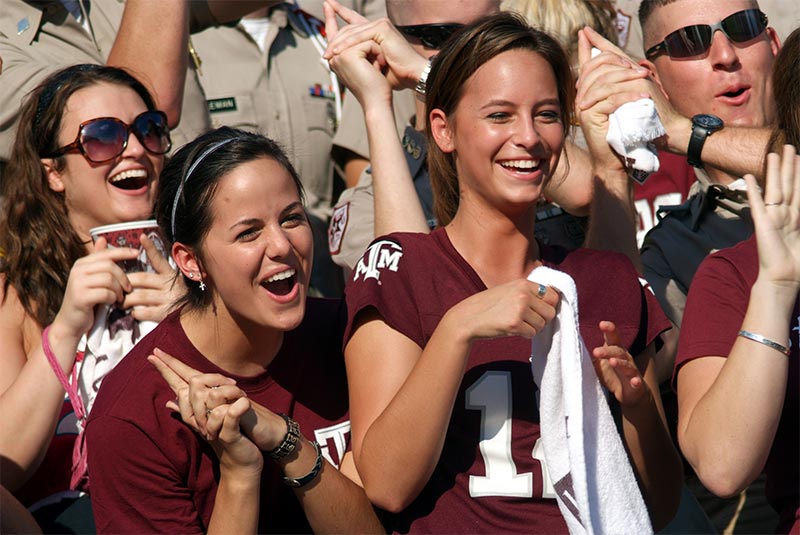The now-ubiquitous cry of "Whoop!" is relatively new to A&M.
Stories have circulated over the years that it's what cavalry riders called out to alert those marching behind them when the horses would drop a few "road apples," or that it's a descendant of the Southern rebel yell.
Instead, it seems to have developed in the '60s and '70s as a shout of approval, much as it's used today.
"They weren't doing it when Ross was here (1891-1898, when Sul Ross was A&M's president); they weren't doing it in the teens, they weren't doing it in the '20s," says A&M historian John Adams '73.
These days – in fact, ever since the 1980s – you can't do an Aggie yell without hearing a chorus of "Whoooooop!" at the end.
 The Association of Former Students
The Association of Former Students
In the 1940s, though, yells ended with the general "Aaaaaaaa" that's today called the freshman "wildcat" -- at least if you judge by a circa-1940 recording of the Aggie Band (tx.ag/c1940) and the wartime movie "We've Never Been Licked," filmed on A&M's campus in 1942-43.
By the late 1950s, some Aggies recall hearing shouts of "Whooah!" or "Hooah!" during Corps reviews.
Former yell leader Mike Beggs '68 recalled it as "something that originated over on the Army side of the cadet Corps, from the Airborne cadets," who had picked up the Army Airborne call "Hooah!"
Most of the U.S. armed forces have such a call (Navy: "hooyah," Marines: "oorah"; the latter is said to stem from Marines stationed in Korea in 1953).
This spread as a general sign of Aggie approval during the 1960s and, at some point around the early 1970s, acquired a variant that distinctly ended with a "p" sound, the way the word "whoop" is written.
Adams humorously called the newer version "that ‘hoop' noise," and said both "hoop" and "whooah" were around when he was a student, used interchangeably but not in a structured way: at a review, after a touchdown, or when someone dropped a tray of food in Duncan dining hall. "Just kind of an affirmation," he said.
Yell leaders from the Classes of '48 to '87 discuss their familiarity (and unfamiliarity) with the sound and the pointing gesture that's been associated with it since the 1970s:
"Whoop" appears in Bryan Eagle news stories from 1970 and '71 about students reacting to campus speakers, and the 1974 Aggieland describes "Whoop" as a junior privilege.
That tracks with the evolution of "class wildcats" – something that Aggies from the 1970s and before may not be familiar with, but Aggies from the 1980s and after learned along with older Aggie lore.
So far, most Aggies across the decades in our online "informal traditions" poll who remember whooping say it was a privilege restricted to juniors and seniors.
Since 2004, the student Class Councils have organized an event each spring called "Pull Out Day" at which the sophomore class comes together for their "first whoop."
Here's the Class of 2018 whooping it up March 4, 2016, at Pull Out Day:
 Texas A&M University
Texas A&M University



